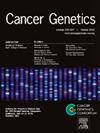Unraveling complex karyotype clonal architecture: co-existing double TP53 mutations alongside DNMT3A, TET2, and NF1 mutations – a case study
IF 2.1
4区 医学
Q4 GENETICS & HEREDITY
引用次数: 0
Abstract
Complex chromosomal changes in Acute Myeloid Leukemia (AML) are highly heterogeneous, with disease progression shaped by both the number and nature of abnormalities. Rarely do, multiple unrelated clones with independent chromosomal changes coexist at diagnosis.
Present study showcases a comprehensive characterization of two cytogenetically distinct complex clones in AML, driven by non-cyclic and chromoplexy mechanisms, highlighting their co-existence with key molecular alterations (TP53, NF1, DNMT3A, TET2) along with their potential contribution to clonal evolution.
In the present study a refined assessment of clonal chromosomal complexity is provided, with each clone exhibiting distinct alterations involving chromosomes 5, 14, and 17 along with variant structural formation of chromosomes ie. isochromosome 5p, partial monosomy 7 and derivative 17, defining the heterogeneity of clonal architecture.
Additionally, we propose a probable association between mutational burden and chromosomal complexity, as evidenced by the coexistence of distinct clones with varying mutation loads and cytogenetic profiles, reflecting parallel clonal evolution.
Our integrated approach combining karyotyping and fluorescence in situ hybridization (FISH) was essential in unraveling the clonal architecture, providing valuable insights into the personalized chromosomal alterations and pathogenetic mechanisms that would be helpful for refining prognosis and guiding AML management.
解开复杂核型克隆结构:双TP53突变与DNMT3A, TET2和NF1突变共存-一个案例研究
急性髓性白血病(AML)的复杂染色体变化是高度异质性的,疾病进展由异常的数量和性质决定。在诊断时,具有独立染色体变化的多个不相关克隆共存的情况非常罕见。本研究展示了AML中两个细胞遗传学上不同的复杂克隆的全面特征,由非循环和色plexy机制驱动,突出了它们与关键分子改变(TP53, NF1, DNMT3A, TET2)的共存以及它们对克隆进化的潜在贡献。在目前的研究中,提供了克隆染色体复杂性的精细评估,每个克隆都表现出涉及染色体5、14和17的不同改变,以及染色体的不同结构形成。同染色体5p,部分单体7和衍生物17,定义克隆结构的异质性。此外,我们提出突变负担与染色体复杂性之间可能存在关联,这可以通过具有不同突变负荷和细胞遗传学谱的不同克隆共存来证明,这反映了平行克隆进化。我们结合核型和荧光原位杂交(FISH)的综合方法对于揭示克隆结构至关重要,为个性化染色体改变和发病机制提供了有价值的见解,有助于改善预后和指导AML管理。
本文章由计算机程序翻译,如有差异,请以英文原文为准。
求助全文
约1分钟内获得全文
求助全文
来源期刊

Cancer Genetics
ONCOLOGY-GENETICS & HEREDITY
CiteScore
3.20
自引率
5.30%
发文量
167
审稿时长
27 days
期刊介绍:
The aim of Cancer Genetics is to publish high quality scientific papers on the cellular, genetic and molecular aspects of cancer, including cancer predisposition and clinical diagnostic applications. Specific areas of interest include descriptions of new chromosomal, molecular or epigenetic alterations in benign and malignant diseases; novel laboratory approaches for identification and characterization of chromosomal rearrangements or genomic alterations in cancer cells; correlation of genetic changes with pathology and clinical presentation; and the molecular genetics of cancer predisposition. To reach a basic science and clinical multidisciplinary audience, we welcome original full-length articles, reviews, meeting summaries, brief reports, and letters to the editor.
 求助内容:
求助内容: 应助结果提醒方式:
应助结果提醒方式:


